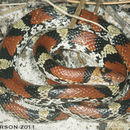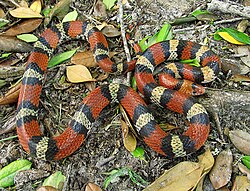mk
имиња во трошки


Die Scharlachnatter (Cemophora coccinea) ist eine ungiftige Natter aus dem Südosten der USA. Die Art gehört zu der Gattung Cemophora und ist in drei Unterarten aufgeteilt.
Scharlachnattern sind mit einer Größe von 36 bis 51 cm eine relativ kleine Schlangengattung. Sie sind hellgrau und haben auf der Rückseite rote Flecken, die schwarz umrahmt sind. Ihre Bauchseite ist gleichmäßig hellgrau. Da ihre Flecken sich teilweise bis zum Unterkörper ziehen und dadurch Streifen gebildet werden, kann sie leicht mit der Korallenotter oder der roten Königsnatter verwechselt werden.
Cemophora sind nachtaktiv und verbringen allgemein ihren Tag unter Blättern und Baumstämmen. Erst abends kommen sie aus ihrem Versteck, um auf Nahrungssuche zu gehen. Zu ihrer Nahrung gehören Eidechsen, kleine Nagetiere, Reptilieneier und andere Schlangen. Die Fortpflanzung der Tiere erfolgt während des Frühlings. Im Sommer legen sie gewöhnlich 3–8 Eier, aus welchen im frühen Herbst die kleinen Nattern schlüpfen.
Die früher ebenfalls als Unterart der Scharlachnatter eingestufte Texas-Scharlachnatter (Cemophora lineri (Williams, Brown & Wilson, 1966)) wird mittlerweile als eigenständige Art eingestuft.
Die Scharlachnatter (Cemophora coccinea) ist eine ungiftige Natter aus dem Südosten der USA. Die Art gehört zu der Gattung Cemophora und ist in drei Unterarten aufgeteilt.
Cemophora coccinea, commonly known as the scarlet snake, is a species of nonvenomous snake in the family Colubridae. The species is native to the southeastern United States. There are two subspecies of C. coccinea that are recognized as being valid. The Texas scarlet snake (C. lineri) was previously considered a subspecies.
The scarlet snake is relatively small, growing to a total length (including tail) of 14-26 inches (36–66 cm) at adult size. The dorsal pattern consists of a light gray ground color, with a series of black-bordered red, white or yellow blotches down the back. The belly is either a uniform light gray or white color. The dorsal blotches can extend down the sides of the body, appearing somewhat like banding or rings, which sometimes leads to confusion with other sympatric species such as the venomous coral snakes or the harmless scarlet king snake.[6]
C. coccinea is found only in the United States, in southeastern Texas, eastern Oklahoma, Arkansas, parts of Louisiana, Mississippi, Alabama, Georgia, Florida, South Carolina, North Carolina, Tennessee, Kentucky, Illinois, Indiana, Virginia, Maryland, and Delaware; with disjunct populations in New Jersey and central Missouri. The species is more commonly found throughout most of the Atlantic coastal plain areas. They prefer open forested areas with sandy soil, ground litter, and organic debris.[6]
In Indiana, the scarlet snake is listed as an endangered species.[7] In New Jersey, the scarlet snake has been recommended by the New Jersey Endangered and Nongame Advisory Committee that it be put on the threatened status for this species within the state, but no formal rule proposal has been filed to date. The Threatened status is largely due to population declines and habitat loss. Reasons for the decline in their population are a loss of habitat, illegal capture for the pet trade, road mortality, and direct killing.[8]
The scarlet snake is nocturnal and is active only during the summer months. They can be found during the day beneath logs, under pine debris or other organic litter. They also burrow underground during the daytime hours, or use previously dug tunnels to reside in.[9] At night they are often seen crossing roads, setting out to look for food. C. coccinea's diet consists of lizards, small rodents, the eggs of lizards, turtles, and other snakes. Their large, very sharp posterior teeth are used to slash open large reptile eggs. The snake will either squeeze an egg to expel its contents or thrust its head into the egg to break it open. The smallest reptile eggs are eaten in their entirety.[6]

There is very little known about the reproductive habits of the scarlet snake. It is oviparous, generally laying 2-9 eggs per clutch, with the typical clutch yielding five eggs. Breeding occurs throughout the spring months, and eggs are laid throughout the summer in burrows or under rocks. The eggs hatch two months after breeding, typically in the late summer or autumn.[6]
The natural predators of the scarlet snake are snake-eating snakes such as the coral snake, and predatory birds and mammals. Scarlet snakes rarely bite when picked up by humans, although they can release a foul-smelling odor.[6] The Scarlet snake will use its version of batesian mimicry and mimic the coral snake as a defense mechanism in order to reduce predation, and show predators that it is a venomous species.[10]
The two greatest threats that scarlet snakes face are the destruction of their habitats because of commercial development and the rising rate of road mortality.[6] Other threats are illegal capture of the species for the pet trade and intentional killing.[8]
The following two subspecies are recognized as being valid.[11]
Nota bene: A trinomial authority in parentheses indicates that the subspecies was originally described in a genus other than Cemophora.
Cemophora coccinea, commonly known as the scarlet snake, is a species of nonvenomous snake in the family Colubridae. The species is native to the southeastern United States. There are two subspecies of C. coccinea that are recognized as being valid. The Texas scarlet snake (C. lineri) was previously considered a subspecies.
Cemophora coccinea Cemophora generoko animalia da. Narrastien barruko Colubridae familian sailkatuta dago.
Cemophora coccinea Cemophora generoko animalia da. Narrastien barruko Colubridae familian sailkatuta dago.
Cemophora coccinea, unique représentant du genre Cemophora, est une espèce de serpents de la famille des Colubridae[1].
Cette espèce est endémique des États-Unis. Elle se rencontre en Alabama, en Arkansas, en Caroline du Nord, en Caroline du Sud, au Delaware, en Floride, en Géorgie, en Illinois, en Indiana, au Kentucky, en Louisiane, au Maryland, au Mississippi, au Missouri, au New Jersey, en Oklahoma, au Tennessee, au Texas et en Virginie[1].
Cemophora coccinea mesure entre 36 et 66 cm. Son dos est blanc-beige avec de larges points rouges délimitées de noir. Les points rouges peuvent parfois se rejoindre jusqu'à donner des bandes transversales. Son ventre est gris clair.
C'est un animal nocturne, qui reste caché au sol durant la journée. Il se nourrit de petits lézards, rongeurs, œufs et parfois d'autres serpents. C'est une espèce ovipare, qui pond en général de 3 à 8 œufs à la fois. La femelle peut pondre plusieurs fois durant la saison.
Selon Reptarium Reptile Database (11 août 2011)[2] :
Cemophora coccinea, unique représentant du genre Cemophora, est une espèce de serpents de la famille des Colubridae.
Ular belang-bata (Cemophora coccinea), adalah sejenis ular kecil dari suku Colubridae. Ular ini adalah satu-satunya jenis dari marga Cemophora. Nama umumnya dalam bahasa Inggris adalah Scarlet snake atau red-banded racer. Dinamai demikian karena warna tubuhnya yang mudah dikenali, yakni warna dasar merah karat seperti warna batu bata dengan belang-belang hitam-putih-hitam (nama spesifik: coccinea = "merah bata"). Selain ular belang bata, banyak spesies ular dari genus lain yang juga memiliki pola warna yang sama misalnya dari genus Lampropeltis sp. dan Erythrolamprus sp.. Warna tubuhnya belang "merah-hitam-putih-hitam-merah", "merah-hitam-kuning-hitam-merah", "merah-hitam-oranye-merah", dan/atau "merah-hitam-merah-hitam-merah". Ular-ular dengan pola belang-belang "tiga-warna" seperti ini hanya terdapat di Amerika.
Ular belang-bata merupakan ular yang berukuran kecil, panjang tubuhnya hanya mencapai 67 cm. Tubuh bagian atas berwarna belang-belang merah dan putih, dari leher hingga ekor. Belang merah lebih lebar daripada belang putih, dan keduanya dipisahkan oleh belang tipis berwarna hitam. Kepalanya berwarna merah, kecuali bagian bawah berwarna keputihan. Belang berwarna merah paling lebar dan belang berwarna hitam paling sempit. Bagian bawah tubuh berwarna putih-susu. Ular ini tidak berbisa dan tidak berbahaya. Orang awam sering keliru menganggap ular ini adalah ular karang berbisa karena pola warnanya hampir sama dengan ular karang.[2]
Habitat utama ular ini adalah hutan terbuka. Aktif pada malam hari. Pada siang hari, ular ini bersembunyi di bawah batu atau di dasar pohon yang lebat. Mangsa ular ini adalah kadal kecil, binatang pengerat kecil (atau rodent dalam bahasa Inggris), telur, dan kemungkinan ular lain. Berkembang biak dengan bertelur hingga 8 butir.[2]
Ular ini terdapat di Amerika Serikat bagian selatan dan tenggara.[2]
Ular belang-bata (Cemophora coccinea), adalah sejenis ular kecil dari suku Colubridae. Ular ini adalah satu-satunya jenis dari marga Cemophora. Nama umumnya dalam bahasa Inggris adalah Scarlet snake atau red-banded racer. Dinamai demikian karena warna tubuhnya yang mudah dikenali, yakni warna dasar merah karat seperti warna batu bata dengan belang-belang hitam-putih-hitam (nama spesifik: coccinea = "merah bata"). Selain ular belang bata, banyak spesies ular dari genus lain yang juga memiliki pola warna yang sama misalnya dari genus Lampropeltis sp. dan Erythrolamprus sp.. Warna tubuhnya belang "merah-hitam-putih-hitam-merah", "merah-hitam-kuning-hitam-merah", "merah-hitam-oranye-merah", dan/atau "merah-hitam-merah-hitam-merah". Ular-ular dengan pola belang-belang "tiga-warna" seperti ini hanya terdapat di Amerika.
Cemophora – rodzaj węża z podrodziny Colubrinae w rodzinie połozowatych (Colubridae).
Rodzaj obejmuje gatunki występujące endemicznie w Stanach Zjednoczonych[3].
Cemophora: gr. κημος kēmos „kaganiec”; φoρος phoros „dźwigający”, od φερω pherō „nosić”[4].
Do rodzaju należą następujące gatunki[3]:
Cemophora – rodzaj węża z podrodziny Colubrinae w rodzinie połozowatych (Colubridae).
Cemophora coccinea là một loài rắn trong họ Rắn nước. Loài này được Blumenbach mô tả khoa học đầu tiên năm 1788.[5]
Cemophora coccinea là một loài rắn trong họ Rắn nước. Loài này được Blumenbach mô tả khoa học đầu tiên năm 1788.

 分類 界 : 動物界 Animalia 門 : 脊索動物門 Chordata 亜門 : 脊椎動物亜門 Vertebrata 綱 : 爬虫綱 Reptilia 目 : 有鱗目 Squamata 亜目 : ヘビ亜目 Serpentes 科 : ナミヘビ科 Colubridae 亜科 : ナミヘビ亜科 Colubrinae 属 : スカーレットヘビ属 Cemophora 種 : スカーレットヘビ C. coccinea 学名 Cemophora coccinea
分類 界 : 動物界 Animalia 門 : 脊索動物門 Chordata 亜門 : 脊椎動物亜門 Vertebrata 綱 : 爬虫綱 Reptilia 目 : 有鱗目 Squamata 亜目 : ヘビ亜目 Serpentes 科 : ナミヘビ科 Colubridae 亜科 : ナミヘビ亜科 Colubrinae 属 : スカーレットヘビ属 Cemophora 種 : スカーレットヘビ C. coccinea 学名 Cemophora coccineaスカーレットヘビ(Cemophora coccinea)は、爬虫綱有鱗目ナミヘビ科スカーレットヘビ属に分類されるヘビ。本種のみでスカーレットヘビ属を構成する。
最大全長82.8センチメートル[1]。体鱗には隆起(キール)がない[1]。胴体中央部の斜めに列になった背面の鱗の数(体列鱗数)は19-21[1]。総排出口までの腹面にある幅の広い鱗の数(腹板数)は158-185[2]。総排出口より後部の鱗の数(尾下板数)は36-50対[1]。背面の体色は赤く、黒い横帯に縁取られた黄色い横帯が入る[1][2]。種小名coccineaは「深紅の」の意[1]。腹面の体色は淡黄色でピンクがかることもあり、斑紋は入らない[1]。
吻端は尖り[2]、やや上方へ向かう[1]。虹彩は黒い[1]。瞳孔は大型で、円形[1]。額を覆う鱗(額板)は正方形に近い形状で、頭頂板はやや長い[1]。上唇を覆う鱗(上唇板)のうち2枚が目に接する。上唇板の色彩は橙黄色や白[1]。属名Cemophoraは「髭のある吻端」の意で、明色の上唇板に由来すると考えられている[1]。
卵は長径3-3.5センチメートル[1]。孵化直後の幼蛇は全長12.5-15.2センチメートル[1]。
科内ではショートテールスネーク属やハナナガヘビ属に近縁とされ、これら3属はキングヘビ属(特にミルクヘビ)から分化したと考えられている[1]。
基底が砂やロームでダイオウマツやコナラ属が優占する森林に生息するが、草原や荒野などに生息することもある[1]。地表棲だが、地中棲傾向が強い[1]。夜行性で[2]、昼間は倒木の下や岩の割れ目、茂み、動物の巣穴、自ら掘った巣穴などで休む[1]。危険を感じると地中や物陰に逃げ込むが、逃げ込むことができない場合は頭部を胴体の下へ隠す防御行動を行う[1]。尾を持ち上げる防御行動を行うこともあり、これは同所的に分布するサンゴヘビへの擬態と考えられている[1]。
食性は動物食で、主に小型爬虫類の卵(アメリカナメラ属、キングヘビ属、スジトカゲ属)を食べるが、小型爬虫類そのもの(クビワヘビなど)、小型哺乳類(トガリネズミ属、齧歯類)、昆虫(甲虫類の幼虫)なども食べる[1][2]。卵は殻に噛みついて穴を開けた後に、卵に巻きつき中身を絞り出して食べる[1][2]。大型個体はアナホリゴファーガメの卵も食べることがあり、その場合は殻に穴を開け中に頭部を入れて食べる[1]。
繁殖形態は卵生。北部個体群は3-5月、南部個体群は2-3月に交尾を行う[1]。6-8月に朽木の中や石の隙間に、1回に2-9個の卵を産む[1]。卵は70-80日で孵化する[1]。
広域分布し、生息数は多いと考えられている[1]。一方で亜種テキサススカーレットヘビは分布が限定的で生息数が少ないと考えられており、他亜種も森林伐採や開発による生息地の破壊が懸念されている[1]。
ペットとして飼育されることもあり、日本にも輸入されている。1960年代から輸入されていたとされるが、流通量は少ない。神経質で偏食傾向が強く飼育下では餌付きが悪いこと、野生下で好む爬虫類の卵は安定供給しづらいことなどから、飼育は難しいとされる[1]。